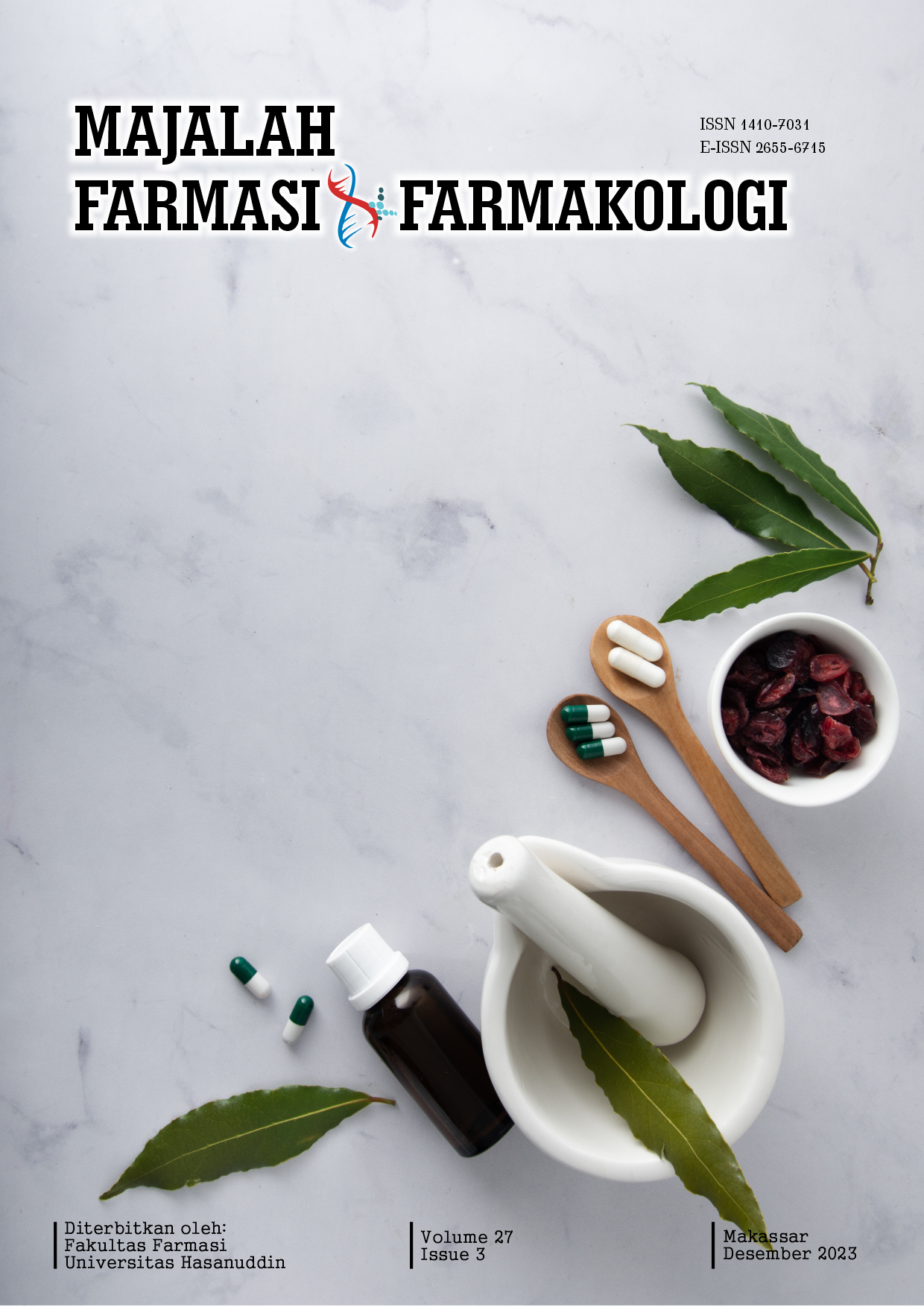PENGARUH METODE EKSTRAKSI TERHADAP KADAR POLIFENOL TOTAL BIJI KAKAO (Theobroma cacao L.) KLON MCC02 ASAL SULAWESI SELATAN
Article History
Submited : July 28, 2023
Published : December 31, 2023
Indonesia merupakan salah satu produsen kakao (Theobroma cacao L.) di dunia dengan berbagai genotype / klon. Salah satu klon terbesar di Sulawesi selatan adalah MCC02 (Masamba Cacao Clone 02). Klon tersebut telah ditanam di beberapa kabupaten di Sulawesi selatan. Polifenol kakao diketahui memiliki aktivitas antioksidan dan antimikroba. Biji kakao mengandung komponen polifenol yang tinggi, salah satu faktor yang mempengaruhi kadar polifenol dalam ekstrak adalah metode ekstraksi. Tujuan penelitian ini adalah untuk mengetahui pengaruh dari metode ekstraksi terhadap kadar polifenol dari ekstrak biji kakao. Buah kakao klon MCC02 diperoleh dari tiga kabupaten yaitu Pinrang, Masamba, dan Bantaeng. Biji kakao kering non fermentasi terlebih dahulu dikeluarkan dari kulit bijinya, kemudian lemaknya dihilangkan dengan menggunakan alat press lemak. Biji kakao tersebut masing-masing diekstraksi menggunakan metode maserasi (M), Microwave Assisted Extraction (MAE), dan Ultrasonic-Assisted Extraction (UAE). Hasil ekstraksi dengan menggunakan metode M, MAE dan UAE diperoleh rendemen, masing-masing: 15,29 ± 0,66 %, 13,13 ± 0,28 % dan 12,77 ± 1,12 % dan kandungan rata-rata polifenol total, yaitu: (28,89 ± 4,53) %, (31,90 ± 3,34) %, (36,07 ± 4,41) % dihitung ekivalen asam galllat. Dari ketiga metode ini kadar polifenol total tertinggi ada pada metode ekstraksi menggunakan Ultrasonic-Assisted Extraction (UAE).
References
- Aguilar-Hernández, G., De Lourdes García-Magaña, M., De los Ángeles Vivar-Vera, M., Sáyago-Ayerdi, S. G., Sánchez-Burgos, J. A., Morales-Castro, J., Anaya-Esparza, L. M., & González, E. M. (2019). Optimization of ultrasound-assisted extraction of phenolic compounds from annona muricata by-products and pulp. Molecules, 24(5), 1–15. https://doi.org/10.3390/molecules24050904
- Ariyanti, M., Rosniati, R., Yumas, M., Wahyuni, W., & Indriana, D. (2021). Kandungan Asam Amino Dan Asam Lemak Kakao Bubuk Tidak Fermentasi Dengan Perlakuan Penyangraian Uap Panas Suhu Rendah. Jurnal Industri Hasil Perkebunan, 16(2), 70. https://doi.org/10.33104/jihp.v16i2.7052
- Biesaga, M. (2011). Influence of extraction methods on stability of flavonoids. Journal of Chromatography A, 1218(18), 2505–2512. https://doi.org/10.1016/j.chroma.2011.02.059
- Febrianto, N. A., & Zhu, F. (2019). Diversity in Composition of Bioactive Compounds among 26 Cocoa Genotypes. Journal of Agricultural and Food Chemistry, 67(34), 9501–9509. https://doi.org/10.1021/acs.jafc.9b03448
- Febrianto, N. A., & Zhu, F. (2022). Composition of methylxanthines, polyphenols, key odorant volatiles and minerals in 22 cocoa beans obtained from different geographic origins. Lwt, 153(August 2021), 112395. https://doi.org/10.1016/j.lwt.2021.112395
- Gil, M., Uribe, D., Gallego, V., Bedoya, C., & Arango-Varela, S. (2021). Traceability of polyphenols in cocoa during the postharvest and industrialization processes and their biological antioxidant potential. Heliyon, 7(8), e07738. https://doi.org/10.1016/j.heliyon.2021.e07738
- Kemenkes R.I. (2011). Suplemen II Farmakope Herbal Indonesia (Direktorat Jenderal Bina Kefarmasian dan Alat (ed.); FIrst Edit). Kemenkes R.I.
- Maldonado, Y. E. (2023). Drying Temperature on Catechins , Procyanidins and.
- Martin, M. Á., & Ramos, S. (2021). Impact of cocoa flavanols on human health. Food and Chemical Toxicology, 151(March). https://doi.org/10.1016/j.fct.2021.112121
- Medina-Torres, N., Ayora-Talavera, T., Espinosa-Andrews, H., Sánchez-Contreras, A., & Pacheco, N. (2017). Ultrasound assisted extraction for the recovery of phenolic compounds from vegetable sources. Agronomy, 7(3). https://doi.org/10.3390/agronomy7030047
- Montagna, M. T., Diella, G., Triggiano, F., Caponio, G. R., De Giglio, O., Caggiano, G., Di Ciaula, A., & Portincasa, P. (2019). Chocolate, “food of the gods”: History, science, and human health. International Journal of Environmental Research and Public Health, 16(24). https://doi.org/10.3390/ijerph16244960
- Oracz, J., Zyzelewicz, D., & Nebesny, E. (2015). The Content of Polyphenolic Compounds in Cocoa Beans (Theobroma cacao L.), Depending on Variety, Growing Region, and Processing Operations: A Review. Critical Reviews in Food Science and Nutrition, 55(9), 1176–1192. https://doi.org/10.1080/10408398.2012.686934
- Sari, I. A., Murti, R. H., Misnawi, Putra, E. T. S., & Susilo, A. W. (2022). Sensory profiles of cocoa genotypes in Indonesia. Biodiversitas, 23(2), 648–654. https://doi.org/10.13057/biodiv/d230205
Ma’ruf, D., Sartini, S., subehan, Gemini alam, Herlina Rante, & Firzan Nainu. (2023). PENGARUH METODE EKSTRAKSI TERHADAP KADAR POLIFENOL TOTAL BIJI KAKAO (Theobroma cacao L.) KLON MCC02 ASAL SULAWESI SELATAN. Majalah Farmasi Dan Farmakologi, 27(3), 93-95. https://doi.org/10.20956/mff.v27i3.27962
Copyright (c) 2023 Array

This work is licensed under a Creative Commons Attribution-NonCommercial 4.0 International License.
Downloads
Download data is not yet available.
Fulltext
